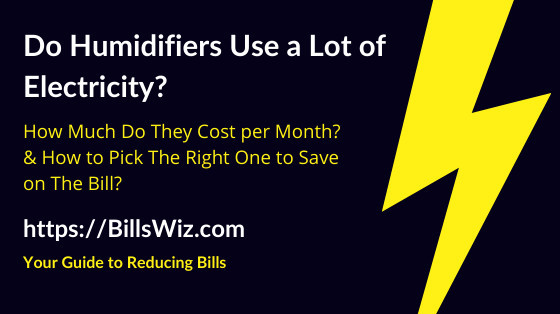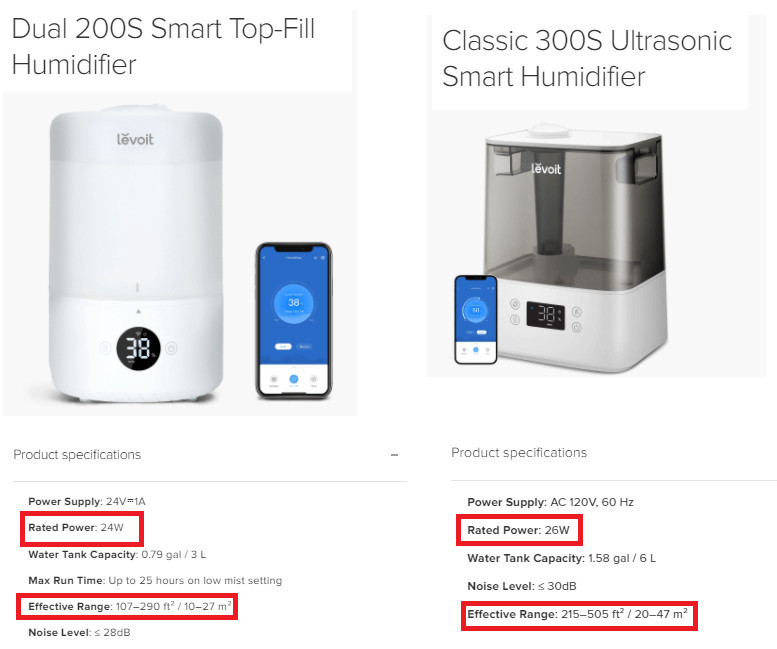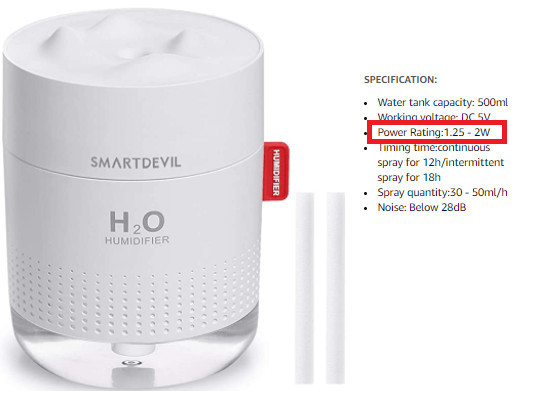Do humidifiers use a lot of electricity and cost a lot to run?
Do they increase or decrease your electricity bill?
What is the difference between cool mist and warm mist humidifier when it comes to energy consumption, and how to choose energy efficient humidifiers in order to keep your bill to the lowest?
These questions and more, I will be answering in this short article in order to help you know if you should get a humidifier was a good idea or not.
Without further ado, let’s begin!
Do Humidifiers Use a Lot of Electricity?
No, humidifiers do not use a lot of electricity compared to other main appliances such as air conditioners and space heaters, but they use an amount of electricity that is similar to what air purifiers and dehumidifiers consume.
Humidifiers offer health and comfort benefits, and running them all the time might be necessary for some people with some health conditions that require a certain level of humidity to be around in order to feel comfortable.
Also, low humidity in cold weather would make people feel even colder, and a humidifier can be used to raise the humidity in a space, which makes it feel a little bit warmer, and thus, reducing the heating bills in winter.
Recommended for US Homeowners:
Related: Worried about Your Next Electricity Bill? Here’s How 1,000’s of US Homeowners Get Almost $0 Bills!
Related: Are You Missing Out on This Tax Credit Opportunity? (And 3 Other Benefits!)
How Much Electricity Does a Humidifier Use?
On average, a humidifier uses between 25-50 watts of electric power in order to run with a coverage area of between 110-500 sq.ft. (10-47 square meters).
That translates into 0.025-0.05 kWh (kilowatt-hour) of energy for every hour of its operation, which accumulates into 0.6-1.2 kWh per day, assuming that you leave it on for 24 hours a day, and around 18-36 kWh per month, which is not that significant.
Note that this is the average consumption, and some mini humidifiers might use much less power, such as the H2O humidifiers for small rooms that use between 1-2 watts to run, which accumulates into 0.024-0.048 kWh per day, and 0.72-1.44 kWh per month.
And some big humidifiers that cover larger areas, such as the Honeywell whole house humidifier that covers around 4,500 sq.ft. (418 sq. meters), consumes around 84 watts to run, which amounts into around 2 kWh per day, and 60 kWh per month, when run 24 hours every day, on the highest setting.
Note that all of the above is for cool mist humidifiers, which use either a fan or an ultrasonic technology to spray cool mist into the air and increase humidity.
There’as another type of humidifiers, known as warm mist humidifiers, that use a heat element to boil the water and release warm mist into the air, thus, making the room air moisturized and warmer.
But these warm mist humidifiers use more electricity than cools mist humidifiers in order to operate that heating element.
How Much Electricity Does a Warm Mist Humidifier Use?
On average, a warm mist humidifier uses around 250 watts of electricity in order to run, which translates into 0.25 kWh of energy per hour of operation, and 6 kWh per day when used on the highest setting for 24 hours, with the coverage area of around 430-750 sq.ft. (40-70 sq. meters.).
Over the month, the warm mist humidifier uses around 180 kWh when running at the highest setting for 24 hours a day, every day of the month.
Some warm mist humidifiers might consume more or less energy, depending on efficiency, and on the area they are being used to cover.
As you have noticed, a warm mist humidifier uses around five times of energy compared to a cool mist humidifier that is supposed to cover the same area, due to using a heating element that would heat water to up to the boiling temperature where it converts into steam.
And some humidifiers, like the Levoit hybrid humidifiers, come with both options; cool mist and warm mist through the same unit.
It is important to note that all of these numbers are estimates based on the average size humidifiers available in the market, and assuming that you run them all the time, at the highest setting.
The actual electricity consumption of a humidifier may vary based on the following:
- The size of the humidifier based on the coverage area that it is designed to work with.
- The actual wattage of the humidifier as it might differ from one manufacturer to another even for humidifiers that are comparable in sizing.
- The setting on which you leave the humidifier most of the time, as many come with different settings to change the moisture intensity based on your needs.
- For many hours you leave the humidifier on every day, as for some spaces, you might not need to leave the humidifier on all the day.
Do Room Humidifiers Increase Your Electric Bill?
Room humidifiers use electricity in order to run, and therefore, they will add some money to your bill at the end of the month, which depends on the actual consumption of your humidifier as explained in the previous section.
However, in winter, if they air is very dry inside, then the humidifier, in addition to its health benefits, can help you feel a bit warmer by increasing the humidity, which might help you save on heating costs, which could be reflected into reducing the electric bill in winter if you use electricity based heating systems and appliances.
Are Humidifiers Expensive to Run?
Humidifiers, especially cool mist humidifiers, are not considered one of the big electrical loads, and therefore, they are not that expensive to run.
However, warm mist humidifiers use more electricity than cool mist humidifiers, and if they were left running on the highest setting for 24 hours a day, every day of the month, then they might add a significant amount to your electric bill.
How Much Does a Humidifier Cost to Run?
On average, a humidifier costs around 8.4-16.8 cents per day in order to run for 24 hours, on the highest setting, with the average electricity price of 14 cents/ kWh.
In a month, the humidifier would cost between $2.52-$5.04 if it was kept running for 24 hours a day, every day of the month.
Note that the cost might be different from one location to another as utility companies charge different energy rates.
In Idaho, where electricity is cheaper, the total cost of running the humidifier would be lower ($1.9-$3.8 per month), while in Connecticut, where the electricity is more expensive, the cost to run the humidifier would be higher ($4.11-$8.22 per month)
This is for the average cool mist humidifier that uses between 25-50 watts in order to run, as explained earlier.
Mini humidifiers, like the H2O 500 ml SmartDevil humidifiers, might cost between 10-20 cents per month if it was kept running for 24 hours a day, every day of the month.
For a Honeywell whole house humidifier that covers around 4,500 sq.ft. using around 84 watts to run, with the total consumption of 2 kWh per day, the total cost per day would be around 28 cents when left running all the day at the highest setting, which accumulates into around $8.4 per month.
These running cost estimates are all for cool mist humidifiers.
How Much Does a Warm Mist Humidifier Cost to Run?
A warm mist would cost an average of around 84 cents per day, and around $25.2 per month in order to run 24 hours a day, every day of the month, based on the average wattage of 250 watts, and the average electricity rate of 14 cents/kWh.
In a state like Idaho, where the electricity rates are lower, the cost would be around 63 cents per day, and around $19 per month.
And in Connecticut, where the rates are higher, the cost of running a warm mist humidifier would be around $1.37/day, and $41 per month.
Warm mist humidifier could add a lot to your electric bill if you leave them on the highest setting for 24 hours a day, every day of the month.
How to Pick The Best Energy Efficient Humidifiers
There are many brands that sell energy efficient humidifiers, such as Levoit, Honeywell, Dyson, Crane, Vicks, and others.
When shopping for a humidifier, consider the following:
- The area that needs to be covered by the humidifier.
- The need for a warm mist or just a cool mist humidifier.
- The wattage of the humidifier.
- The ability to change the intensity settings.
- The availability of a humidistat and a timer in order to regulate the operation of the humidifier instead of running all the time non-stop.
- The mechanism that operates the humidifier, as ultrasonic humidifiers is quieter than fan-powered humidifiers.
- Whether it has a compartment for essential oil or not.
Choose the humidifier that is designed for an area that is closest to the area of the room where you want to use it, and for bedrooms, ultrasonic humidifiers are better as they are quieter when running.
And in case that you need a warm mist humidifier, then you may consider a hybrid humidifier that can work as both: a warm mist and a cool mist humidifier.
Conclusion – Humidifiers Can Save You Money
Humidifiers do not use a lot of electricity and do not cost a lot of money to run, unless you are using a warm mist humidifier and you keep it running on the highest setting all the time.
In general, humidifiers can help you maintain a comfortable level of humidity that helps you lower your heating bill in winter as dry air will make if feel colder and would make you consume more energy to heat your home or office.
And in general, a humidifier, even a warm mist one that costs more than a cool mist humidifier to run, might help with health related issues, which reduces your overall spending on medications.
If you are considering a warm mist humidifier, then you may keep its running cost to the lowest by setting the humidifier on the setting that gives you the comfort you need instead of leaving it on the highest setting, and by using a humidifier with a humidistat and a timer in order to turn itself off when a certain humidity level is reached or when a certain period of time has passed.
I hope that my article was helpful and that I have answered all of your questions!
If you still have any question on this topic, please, feel free to ask me in the comments’ section below, and I will do my best to help you out







